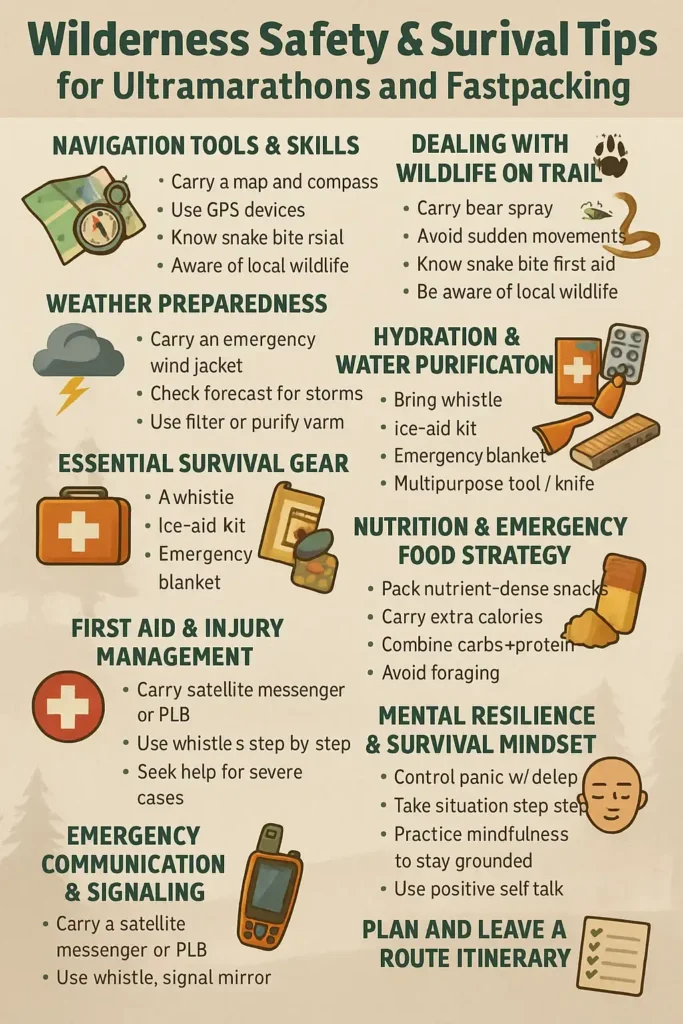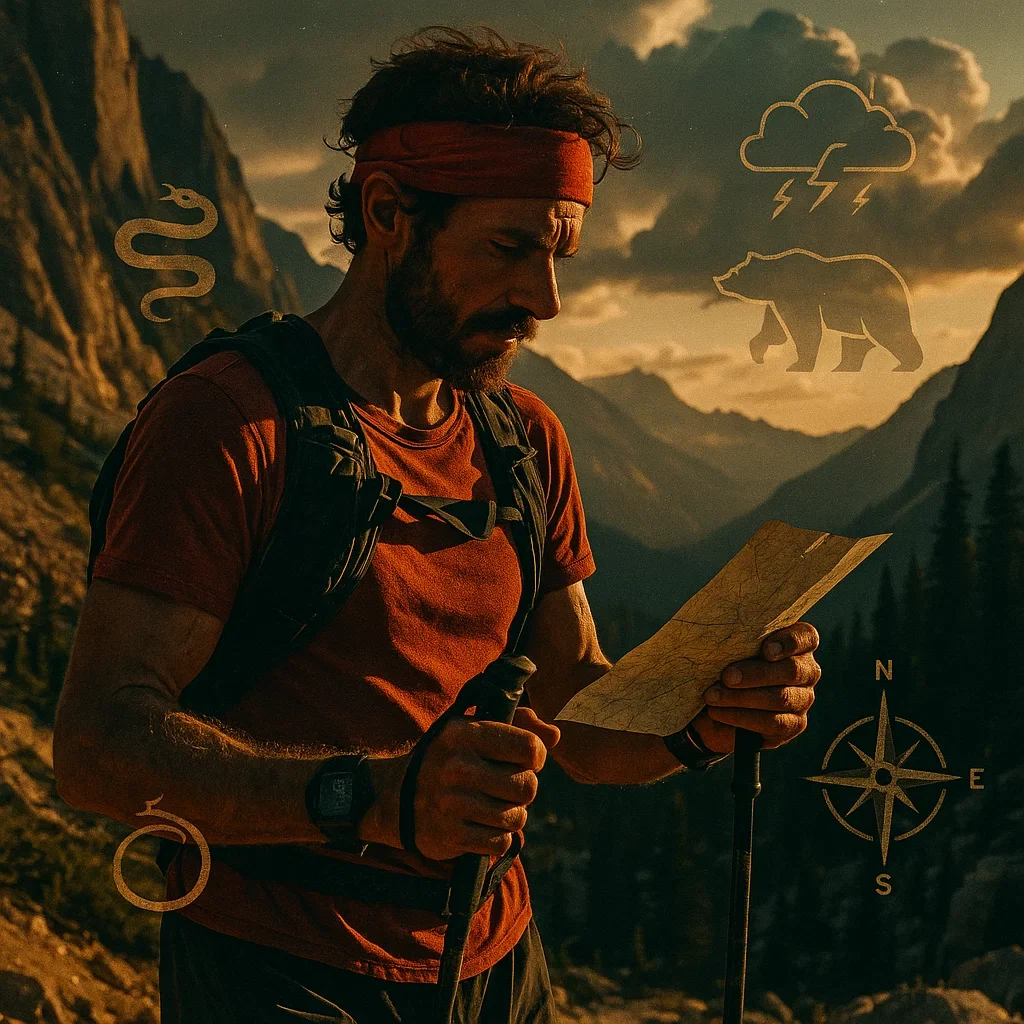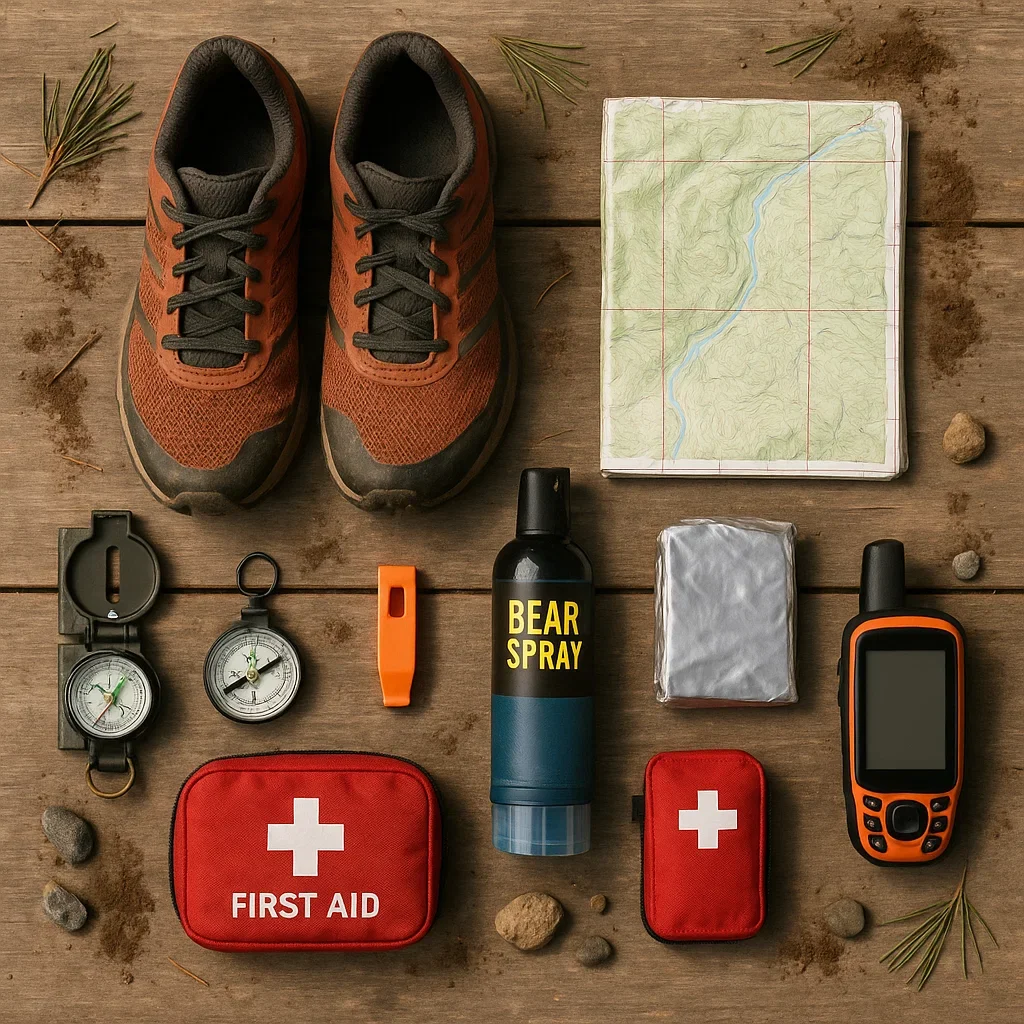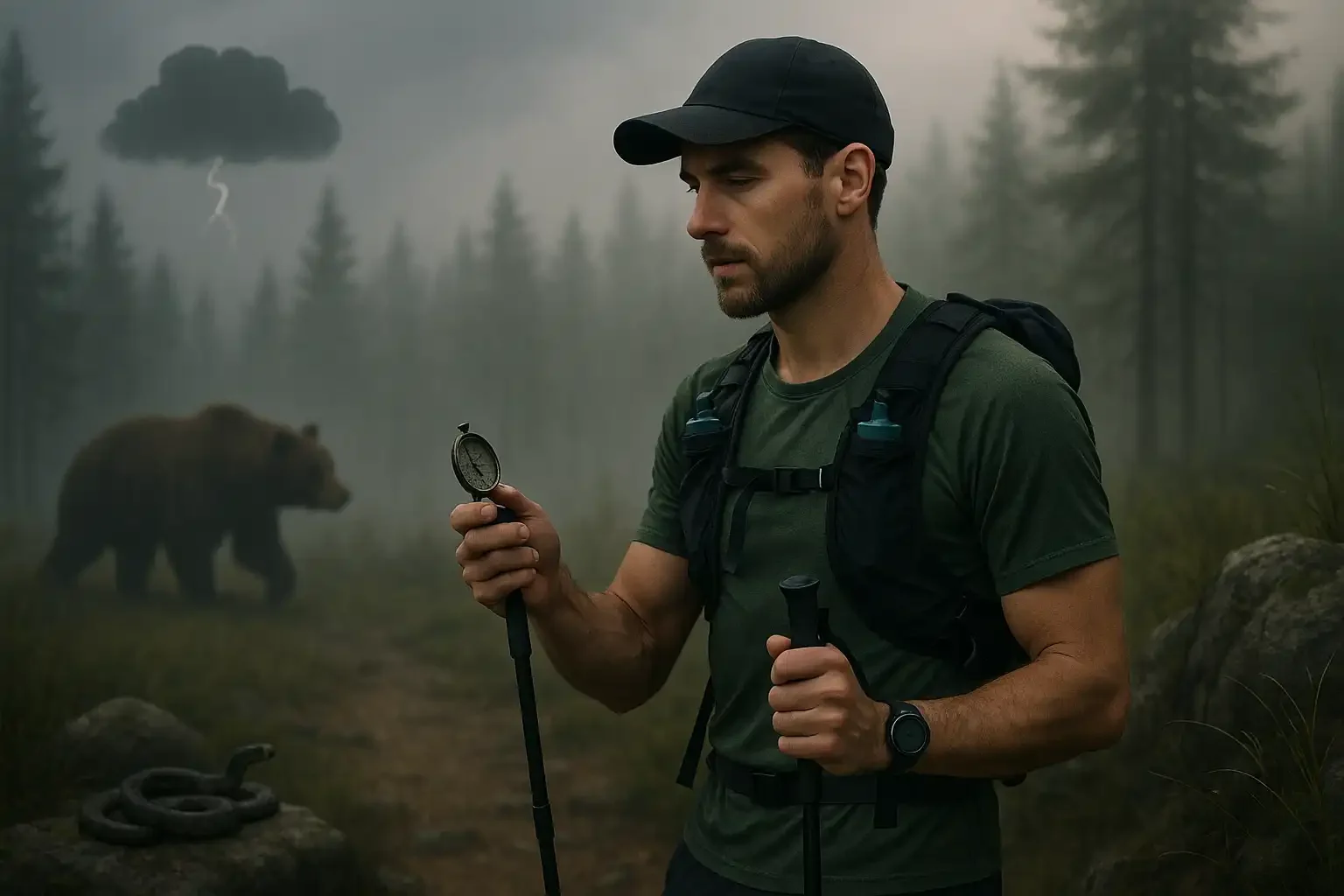Venturing into remote trails is one of the most rewarding aspects of ultrarunning and fastpacking—but it also comes with unique risks. From unpredictable weather to wildlife encounters, a lack of preparation can turn an epic adventure into a dangerous ordeal. This guide will walk you through essential wilderness safety skills, gear, and mindset strategies every ultrarunner or fastpacker should know before heading into the wild.
1. Route Planning & Pre-Run Prep
The best way to stay safe on the trail is to prepare thoroughly before you ever lace up your shoes. Knowing your route, expected conditions, and your personal limits is the foundation of wilderness safety.
✅ Study the Route
Use tools like CalTopo, Gaia GPS, or AllTrails to map out your run or fastpack trip. Look for:
- Elevation gain
- Water sources
- Trail conditions
- Emergency exit points
Print a topographic map or save an offline version on your phone. Don’t rely solely on signal-dependent apps.
📍 Understand the Terrain & Season
Know what to expect in terms of:
- Snowpack or ice (if running early or late season)
- Wildfire zones or burn areas
- Flood-prone crossings after rain
- Local trail closures
Even “known” routes can drastically change depending on season or recent weather.
📤 Share Your Plan
Always leave your itinerary, estimated return time, and trailhead details with a friend or family member. Use services like Garmin LiveTrack or Strava Beacon if you’re carrying GPS.
⚠️ Assess Your Fitness & Fuel Plan
Don’t plan a 40-mile ridge traverse solo if your recent training has been mostly treadmill runs. Match your physical readiness with the demands of the trail. Also plan nutrition based on total hours, not just distance.

2. Navigation Tools & Skills
Navigation isn’t just for mountaineers—it’s a core skill for ultrarunners and fastpackers, especially in remote or unfamiliar terrain. A wrong turn can add hours (or danger) to your outing. Learning how to find your way—and what tools to trust—can save your life.
🧭 Essential Tools to Carry
At minimum, bring:
- A topographic map (laminated or in a ziplock)
- A compass (and know how to use it)
- A GPS watch or handheld device (Garmin, Coros, Suunto)
- A fully charged smartphone with offline maps
Don’t rely solely on GPS — batteries fail, screens crack, and cloud cover can disrupt signals.
📲 Best Offline Map Apps for Runners
- Gaia GPS – great for US terrain with layers like slope angle or public land.
- AllTrails Pro – user reviews and GPX downloads.
- Organic Maps – open-source and super battery-efficient.
Save multiple formats (e.g., PDF map + GPX file + offline app) just in case.
🧠 Basic Navigation Skills to Know
You don’t need to be a wilderness guide, but learn:
- How to orient a map using a compass
- How to identify your location by using terrain features (ridgelines, rivers, forks)
- How to “handrail” a trail (follow natural boundaries like streams or ridges)
- How to backtrack safely if disoriented
🔋 Battery & Backup Strategy
- Keep your phone in airplane mode to conserve power.
- Bring a small power bank or solar charger for longer outings.
- In cold conditions, carry electronics close to your body to preserve battery life.
3. What to Do If You Get Lost
Even experienced runners get turned around in the wilderness. The key to survival isn’t perfection—it’s knowing how to respond when things go sideways.
🛑 Use the S.T.O.P. Method
If you realize you’re off-route, follow this proven process:
- S – Stop: Don’t keep moving aimlessly. Sit down, take a breath.
- T – Think: What was the last confirmed landmark you passed?
- O – Observe: Check your surroundings. Terrain, light, weather?
- P – Plan: Decide your next move based on logic, not fear.
🧠 Early Warning Signs You’re Lost
- You haven’t seen trail markers for over 15–20 minutes.
- Terrain doesn’t match your map/app.
- You feel disoriented even on a visible path (could be on a wrong fork or game trail).
- You’re repeatedly checking your GPS and still confused.
Catch these signs early—the earlier you stop, the better your odds.
🔁 When to Backtrack
If you’re not far off-course:
- Look for your last known location.
- Retrace steps slowly and look behind you often (landmarks look different in reverse).
- Mark confusing turns with natural indicators (a stick arrow, rock stack).
🚨 When to Stay Put and Signal
If light is fading, battery is dying, or terrain is unsafe:
- Find a visible and sheltered location near the trail.
- Use your whistle (3 short blasts = distress).
- Display bright clothing or a bandana on a tree or open area.
- At night, blink a flashlight in regular intervals—it’s easier to spot than a steady beam.
🛰️ Activate SOS (Only If Necessary)
If you’re truly stranded:
- Use a satellite messenger (Garmin inReach, SPOT) to trigger SOS.
- Provide accurate GPS coordinates if you have signal.
- Conserve battery for rescue comms—don’t waste it on checking apps or taking selfies.

4. Weather Awareness & Storm Safety
Weather in the wilderness can flip from sunny to deadly in minutes—especially in mountains or remote forests. For ultrarunners and fastpackers, weather awareness isn’t a luxury—it’s a survival skill.
⛅ Know Before You Go
Check detailed forecasts on:
- Mountain-Forecast.com – elevation-specific weather
- Windy.com – great for wind, rain, and storm tracking
- YR.no – precise and trusted by Nordic outdoors experts
Also, research historical weather patterns for the region—some trails are notorious for afternoon lightning or fog.
⚡ Thunderstorm Safety
If thunder is close enough to hear, it’s close enough to strike.
- Get below treeline as quickly as possible.
- Avoid ridges, summits, caves, and isolated tall trees.
- Squat low on an insulating item (e.g., backpack), feet together.
- Don’t hold metal poles (e.g., trekking poles).
Rule of thumb: Count seconds between flash and thunder—under 30 seconds = danger zone.
☀️ Heat Risk: Know the Signs
- Heat exhaustion: heavy sweating, fatigue, nausea.
- Heat stroke (life-threatening): confusion, no sweat, hot skin, dizziness.
Run early, wear light clothing, and electrolyte up. Salt loss hits performance and cognition.
❄️ Cold Risk: Hypothermia Happens Fast
Even summer evenings in the mountains can bring dangerous chills.
- Early signs: shivering, clumsiness, slurred speech.
- Pack an emergency bivvy or foil blanket.
- Layer properly: base (moisture-wicking), insulation (fleece/down), and shell (wind/waterproof).
- If wet + windy + tired = high hypothermia risk even in temps above freezing.
🌧️ Rain & Flash Flood Tips
- Avoid dry washes, canyons, and river crossings during storms.
- Pack a waterproof layer and stash gear in dry bags.
- Use trail gaiters to keep debris out and help stay warm.
5. Dealing with Wildlife on the Trail
Remote trails often mean sharing space with animals. While most wildlife prefers to avoid humans, surprise encounters can quickly escalate. Knowing how to act—and react—can prevent injuries, or worse.
🐻 Bear Encounters
Brown (grizzly) bears:
- Found in the Rockies, Alaska, and some parts of Canada.
- Don’t run! Back away slowly.
- Carry bear spray and know how to use it—aim low, short burst, then retreat.
Black bears:
- More common across North America.
- Often more curious than aggressive.
- Make noise, stand tall, wave arms, shout. Don’t turn your back.
✅ Tip: If a bear stands on its hind legs, it’s likely trying to identify you, not attack.
🐍 Snakes
- Most snake bites occur when runners step on or near them.
- In the Southwest US, watch for rattlesnakes.
- Stay in the middle of the trail and avoid stepping over logs blindly.
- If bitten:
- Stay calm and keep the affected limb immobilized and below heart level.
- Do not suck out venom or use a tourniquet.
- Seek help as quickly as possible.
🦁 Mountain Lions
- Found in the Western US.
- Very rare, but if encountered:
- Do not crouch or run.
- Make yourself look big—raise arms or use jacket.
- Speak firmly and back away slowly.
- Fight back aggressively if attacked—go for eyes.
🐗 Wild Boars / Moose / Coyotes
- Wild boars can charge—especially females with piglets. Avoid dense brush, give them space.
- Moose are unpredictable and highly territorial. Never approach, especially with calves nearby.
- Coyotes typically avoid confrontation but may follow you. Don’t panic; just maintain presence and pace.
🧢 Prevention is Best
- Run with a buddy or group in known wildlife zones.
- Make occasional noise—talk, clap, or use a bell.
- Store snacks in odor-proof bags.
- Avoid twilight hours (dawn/dusk) when animals are most active.

6. Water Sourcing & Purification
In the backcountry, access to clean water can be the difference between thriving and barely surviving. Dehydration creeps in faster at altitude and under heat, and drinking untreated water can wreck your stomach mid-run—or worse.
💧 Where to Find Water
Even in arid zones, you can often find:
- Streams and rivers — best source, but still treat!
- Snowmelt runoff — cold and clean, but still filter.
- Lakes and ponds — usable, but higher contamination risk.
- Seeps or springs — often marked on maps, good quality.
- Rain collection — stretch a poncho or use leaves to funnel.
🗺️ Pro Tip: Use offline apps to mark potential water sources along your route.
⚠️ What to Avoid
- Water near livestock, human activity, or stagnant pools.
- Anything with an oily film or strong odor.
- Fast-flowing water is safer—but never assume it’s clean.
🧪 Purification Methods
- Filter bottles or pumps (e.g., Sawyer Squeeze, Katadyn BeFree): great for speed and volume.
- UV sterilizers (e.g., SteriPEN): lightweight and chemical-free.
- Water purification tablets: tiny, backup-friendly. Wait 30+ minutes to be safe.
- Boiling: effective, but not practical mid-run unless overnighting.
Always treat your water, even if it looks crystal-clear.
🥤 Hydration Strategy for Long Days
- Drink before you’re thirsty—aim for 500–750ml per hour.
- Carry electrolytes in hot/humid conditions (tabs, powders).
- Use soft flasks or a hydration bladder—adjust based on refill points.
- Stash a backup purification method, even if just a chlorine dioxide tab.
🚨 Dehydration symptoms: dry mouth, dizziness, nausea, irritability.
If you feel it—stop and hydrate. Don’t “tough it out.”
7. Nutrition & Emergency Food Strategy
Wilderness running burns calories fast—and if you’re out longer than expected, your body and mind will pay the price. Smart fueling isn’t just about performance. It’s about resilience and survival when the unexpected hits.
🍫 What to Pack for Daily Runs
- Calorie-dense, lightweight, non-perishable foods
- Favorites among ultra-runners:
- Nut butters in single-serve packs
- Energy gels or chews
- Dried fruit (dates, raisins, figs)
- Trail mix with nuts and dark chocolate
- Electrolyte drink powders
🧠 Choose foods that are easy to chew and digest—even when you’re tired or altitude-sick.
📦 Emergency Rations
Always carry at least 200–400 spare kcal beyond your plan. Think:
- One “backup” bar (e.g., Probar, Clif, Bobo’s)
- Energy drink mix (sugar + salt = survival fuel)
- Small pack of dates or peanut butter
Hide them in a sealed pouch labeled “EMERGENCY ONLY”.
⏱️ When and How to Eat
- Eat small portions every 30–60 minutes during effort.
- Don’t wait until you’re hungry—appetite fades under stress.
- Combine carbs + a little fat/protein for longer efforts.
🚫 What Not to Do
- Don’t try new foods on a remote run (GI distress = race over).
- Don’t rely on natural foraging unless trained—many wild plants and mushrooms are toxic.
- Don’t skip breakfast before long runs in remote areas.
🥜 Bonus: Cold Weather Fueling
- Appetite drops in the cold, but energy needs increase.
- Choose foods that don’t freeze easily (nut butters, soft bars).
- Keep snacks in inner vest pockets to stay warm and soft.
8. First Aid & Injury Management
You don’t need to be a paramedic to save yourself or someone else on the trail—you just need the right gear, basic skills, and a cool head. A compact first aid kit and quick thinking can mean the difference between a minor inconvenience and a full-blown evacuation.
🧰 Essential First Aid Kit for Runners
Pack light, but smart:
- Blister care: Compeed, Leukotape, moleskin
- Bandages & gauze: for cuts, scrapes, or covering wounds
- Antiseptic wipes or iodine pads
- Duct tape: multi-purpose for everything from shoes to splints
- Tweezers: for ticks or splinters
- Ibuprofen or paracetamol
- Tick remover tool if running in forested or grassy areas
🏷️ Pro Tip: Wrap duct tape around your trekking poles or water bottle to save space.
🦶 Common Trail Injuries & What to Do
- Blisters: Clean, drain fluid with sterilized pin, apply moleskin.
- Sprained ankle: Rest, compression wrap if possible, keep weight off.
- Cuts/lacerations: Clean, apply pressure, bandage. Elevate if bleeding.
- Dehydration cramps: Electrolytes, rest, light stretching.
🧊 Hypothermia or Heat Stroke?
- Hypothermia: Shivering, confusion, loss of coordination.
- Get dry, wrap in emergency blanket, warm fluids if possible.
- Heat stroke: Red hot skin, no sweat, dizziness, nausea.
- Get shade, cool body, rehydrate with salts, seek help fast.
🦟 Insect Bites & Allergies
- Carry antihistamines (e.g., loratadine) if sensitive.
- Apply after-bite cream or vinegar for itching.
- In tick areas, check body after runs. Remove by pulling slowly and straight.
🆘 When to End the Run
If pain alters your gait, vision blurs, or you can’t keep down food or water—stop.
Make a decision with logic, not pride. Injuries are easier to heal than rescues to stage.
9. Emergency Communication & Signaling
When things go wrong in the wilderness, being able to call for help—or at least signal your location—can mean the difference between rescue and real danger. Whether you’re injured, lost, or just delayed, reliable communication can save lives.
📱 Communication Tools
- Smartphone: Great in coverage areas, but limited.
- Satellite messengers (highly recommended):
- Garmin inReach Mini 2
- SPOT Gen4 or SPOT X
- PLBs (Personal Locator Beacons):
- No subscription needed.
- Used for life-threatening emergencies.
- Sends signal directly to search & rescue.
🛰️ Bonus: Devices like inReach allow you to text emergency contacts, not just trigger SOS.
🔋 Battery Survival Tips
- Keep your phone in airplane mode with GPS on.
- Store devices in inner pockets in cold weather to prevent battery drain.
- Use low-battery modes in apps and watches.
- Bring a small power bank (5,000mAh) for peace of mind.
📢 Whistles, Mirrors, and Lights
- Whistle: 3 short blasts = universal distress signal
- Signal mirror: Reflect sunlight at aircraft or ridgelines
- Headlamp: Flashing mode is more visible than steady
- Bright-colored gear: Lay out pack, jacket, or buff on open ground
🪧 Passive Signaling
- Make a visible marker: rocks in an X shape, broken branches, bright tape
- Leave notes or signs at trail junctions if moving (include date/time/direction)
- Use contrast: dark gear on snow, bright on soil or rock
🚨 When to Use SOS
- If you’re seriously injured, lost with no way out, or weather makes movement impossible.
- Use satellite SOS, but include as much location info as possible.
- Stay in one place after triggering SOS unless it’s dangerous.
10. Mental Resilience & Survival Mindset
In the wilderness, your mindset can be more powerful than your gear. Staying calm and thinking clearly during high-stress situations—when you’re lost, injured, or alone—can determine whether you get home safe.
🧠 Control the Panic Spiral
- Panic burns energy, depletes oxygen, and clouds judgment.
- Use the Box Breathing technique:
- Inhale 4 seconds → Hold 4 → Exhale 4 → Hold 4
- Repeat until your heart rate and thoughts slow down
🕯️ Stay Grounded with Micro-Focus
When overwhelmed, focus on small, concrete actions:
- Drink water
- Eat a snack
- Adjust clothing
- Re-check your route
Each small task regains control of your situation.
🗣️ Positive Self-Talk Matters
What you say to yourself out loud matters:
- Replace “I’m screwed” with “I’ve trained for tough days.”
- Use phrases like:
- “One step at a time.”
- “Breathe. Think. Move.”
- “This is temporary.”
🧘♂️ Mindfulness for Survival
Practice mindfulness even during regular runs:
- Notice terrain changes
- Observe how fear feels in the body
- Acknowledge discomfort without judgment
It becomes your autopilot in real emergencies.
🔥 Hope is a Survival Tool
Don’t underestimate the power of believing rescue is possible.
People have survived days and nights in extreme conditions by simply refusing to give up mentally.
🏕️ Bonus Tip: Visualize possible scenarios before your run—not with fear, but with readiness.
✅ Final Thoughts
You don’t have to be a wilderness expert to run safely in remote places. But you do need to prepare like one.
With the right knowledge, gear, and mindset, you can confidently explore wild trails, push your limits, and still come home with epic stories—not rescue reports.
🔗 Internal Links
- 🧭 Navigation Tools & Skills
- 🐻 Dealing with Wildlife on the Trail
- 💧 Water Sourcing & Purification
- 🥪 Nutrition & Emergency Food Strategy
- 🩹 First Aid & Injury Management
- 📡 Emergency Communication & Signaling
- 🧠 Mental Resilience & Survival Mindset
🌐 External Links
- 🐍 Wildlife Safety for Runners: Bears, Snakes, and Mountain Lions
- 🏔️ Mountain Safety Tips From The Pros
- 🧭 What Every Trail Runner Needs To Know About Time In The Wilderness
- 🏃 Everyone Trail Runs Alone — Here’s How to Stay Safe
- 🏃 Fastpacking LIGHT – A Guide
- 🏞️ Fastpacking 101: What You Need for This Running-Backpacking Hybrid
- 🥾 Guide to Your First Overnight Fastpacking Trip
🧭 Frequently Asked Questions
What should I do if I get lost during a trail run?
Do I need to carry a map and compass if I have a GPS watch?
How can I safely run in bear country?
Is it okay to drink from mountain streams without filtering?
What’s the best emergency signaling tool for runners?
Should I pack extra food on short wilderness runs?
How do I avoid hypothermia during a trail run?
What’s the best way to learn wilderness survival basics?
Do I need to worry about mountain lions?
Is fastpacking more dangerous than ultrarunning?
🧪 Wilderness Safety & Survival Quiz
- What does the STOP method stand for when you’re lost?
- A. Stop, Talk, Orient, Proceed
- B. Stop, Think, Observe, Plan ✅
- C. Sit, Track, Organize, Pace
- Which animal should you get loud and wave your arms at?
- A. Grizzly bear
- B. Black bear ✅
- C. Moose
- What is the universal distress signal using a whistle?
- A. Two long blasts
- B. Continuous blowing
- C. Three short blasts ✅
- What’s the best water purification method during a run?
- A. UV sterilizer ✅
- B. Drinking directly from a stream
- C. Using sugar and salt only
- Which item is most essential in your survival kit?
- A. Bear bell
- B. Emergency blanket ✅
- C. Trekking pole basket
- What’s a sign of early hypothermia?
- A. Heavy sweating
- B. Shivering ✅
- C. Tingling toes only
- Which tool allows you to communicate when off-grid?
- A. Regular phone
- B. Compass
- C. Satellite messenger ✅
- Which animals are most active at dawn/dusk?
- A. Bears ✅
- B. Snakes
- C. Coyotes
- What’s the best way to calm panic?
- A. Eat a snack
- B. Box breathing ✅
- C. Run it off
- Which food should be avoided if stranded?
- A. Trail mix
- B. Wild berries you can’t ID ✅
- C. Nut butter packets
✅ Quiz Answers
- 1: B
- 2: B
- 3: C
- 4: A
- 5: B
- 6: B
- 7: C
- 8: A
- 9: B
- 10: B
Wilderness Survival Ultramarathon Fastpacking pdf
🎥 1. How To Trailrun [S3 – EP4] – Survival Kit | Salomon
In this episode, Salomon athlete Stian Angermund-Vik discusses essential gear for trail running endurance races. He emphasizes the importance of carrying a survival kit, including items like a headlamp, emergency blanket, and whistle. The video provides practical advice on preparing for unexpected situations in the wilderness.YouTube
Key Takeaways:
- Importance of a well-equipped survival kit.
- Tips on selecting lightweight and functional gear.
- Real-life scenarios where such gear proves crucial.Reddit
🎥 2. Packing Tips for a Multiday Ultra or Fastpack Adventure
Kris King, Race Director at Beyond the Ultimate, shares insights on packing efficiently for multiday ultra marathons and fastpacking trips. He covers gear selection, weight distribution, and the balance between comfort and necessity. This video is invaluable for runners aiming to optimize their load for extended wilderness excursions.YouTube
Key Takeaways:
- Strategies for minimizing pack weight without sacrificing essentials.
- Recommendations on gear that serves multiple purposes.
- Advice on food and hydration planning for multiday events.
🎥 3. Trail and Hill Running Safety – Essential Kit
This video, produced by Mountaineering Scotland and Trail Running Scotland, focuses on the safety aspects of trail and hill running. It highlights the essential kit runners should carry, including navigation tools, weather-appropriate clothing, and emergency supplies. The video aims to prepare runners for the unpredictable nature of the wilderness.YouTube
Key Takeaways:
- Comprehensive list of safety gear for trail running.
- Emphasis on navigation and communication tools.
- Tips on assessing weather conditions and terrain challenges.YouTube
Feel free to integrate these videos into your content to provide readers with visual and practical guidance on ultramarathon wilderness safety and fastpacking strategies. Let me know if you need further assistance or additional resources!

About the Author
Lost Pace is an ultramarathon runner, shoe-tester and the founder of umit.net. Based year-round in Türkiye’s rugged Kaçkar Mountains, he has logged 10,000 + km of technical trail running and completed multiple 50 K–100 K ultras.
Blending mountain grit with data, Lost analyses power (CP 300 W), HRV and nutrition to craft evidence-backed training plans. He has co-written 260 + long-form guides on footwear science, recovery and endurance nutrition, and is a regular beta-tester of AI-driven coaching tools.
When he isn’t chasing PRs or testing midsoles, you’ll find him sharing peer-reviewed research in plain English to help runners train smarter, stay healthier and finish stronger.
Ultrarunner · Data geek · Vegan athlete

